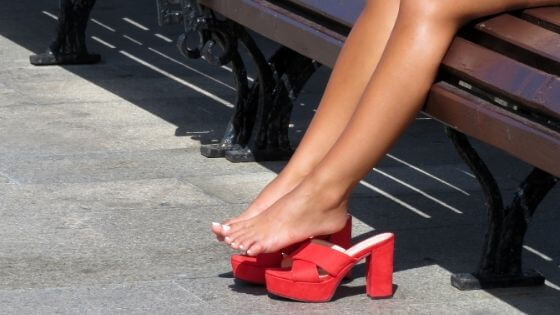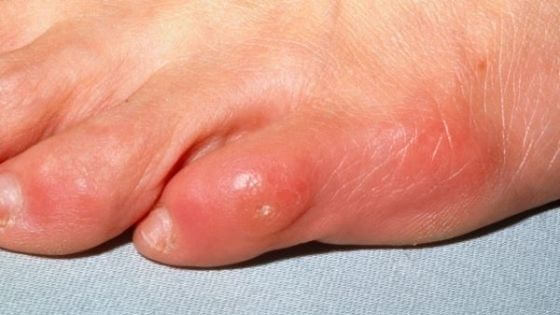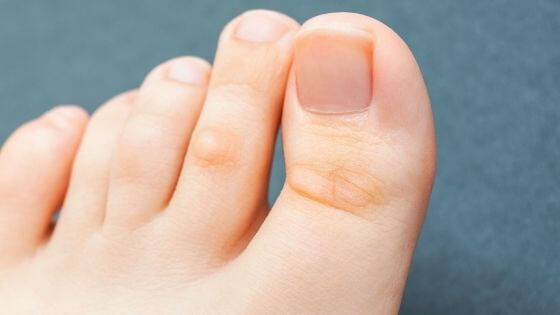How to get rid of calluses on your toes fast, 17 Remedies

Medically reviewed and approved by Nataniel Josue M.D.
How to get rid of calluses on your toes fast? A callus on your foot is annoying and unsightly; they can even prevent you from wearing your favorite shoes or playing sports. After researching in-depth, I will tell you how to get rid of them:
To eliminate calluses on your toes, avoid rubbing on your feet from your shoes. Use socks; look for shoes suitable for your size, which are comfortable, and not high heels. Another way is to moisturize them regularly and soak them, before using a pumice stone or file to soften the callus.
We will show you remedies and treatments and provide some tips to eliminate this problem.
What are calluses?
Calluses are hard, thick layers that form on the skin when it needs to protect itself from friction and pressure. They usually form on the fingers or toes and can be very unsightly.
What causes calluses on toes?
For a healthy person, merely removing the source of friction makes the callus go away. But if you are a person with diabetes or other diseases, there is an increased risk of callus complications.
Calluses can be found on the sides and tips of the toes or between them, as well as on weight-bearing places. It can be painful when you put pressure on them. Corns on the toes begin as a small hardness that serves as a defense mechanism by the skin against the continuous friction of footwear or pressure.
The formation of a callus has three phases:
- Hyperkeratosis, thickening of the skin.
- Irritation of the subcutaneous tissue produces a deep pocket.
- Penetration into more intense areas of the skin, even reaching the bone.
Common causes of calluses on the toes
- Wearing shoes that do not fit properly.
- The use of tight shoes and high heels can compress some parts of the foot.
- Wearing shoes that are too loose, the foot often slips several times against the seam or a stitch inside the shoe when the shoes are open.
- Not wearing socks can cause friction on the feet.
- Wearing shoes or sandals without socks. However, when socks do not fit the foot properly, they can also be a problem.
Types of toe calluses

There are different types of toe callus:
- Soft calluses: these appear in moist areas and must be well cared for so that the toes do not become infected by fungus.
- Hard or vascular callus: they are very painful because they usually touch the nerves that contain blood capillaries.
Symptoms of callus appearance
- The skin is thick and hard.
- There is a raised bump.
- You feel pain or tenderness under the skin.
- The skin becomes dry, or scaly.
Risk factors that increase the chance of callus
- Bunions: an abnormal bony bump that develops on the joint at the base of the big toe.
- Hammertoe: a deformity in which the toe is bent like a claw.
- Another deformity, such as osteophytes: can cause persistent rubbing inside the shoe.
Recommendations to prevent Calluses
- Avoid nail clippers or similar items to remove hardness.
- Avoid humid and warm environments that influence the presence of corns.
- Use flat and ventilated footwear while using treatments.
- To remove calluses, apply a little moisturizing cream or petroleum jelly before using new shoes.
- Reduce the use of high heels as much as possible, as they are the most frequent cause of callus formation.
- Incorporate a foot scrub into your beauty routine to remove dead skin cells.
- Regularly soak your feet in a bowl of water and apple cider vinegar to disinfect them.
- After showering, use a special foot moisturizer.
- Choose good quality athletic shoes.
- Use breathable and thermal socks to avoid moisture.
- Moisturize your feet every day to prevent and heal calluses. Do not apply moisturizer, and then walk barefoot as this can be harmful.
- Maintain the habit of applying moisturizer. Do it before going to sleep with a massage to increase blood circulation.
How to remove calluses on the toes?

There are 2 types of procedures:
Mechanical:
Pumice stone and files.
Soak your feet in warm water for 20 minutes, and then use the pumice stone to scrape the calluses, and rinse well to remove the residue. If necessary, repeat the procedure; but be careful not to touch the healthy parts of the feet which can hurt them. When finishing the pumice stone treatment, you will notice that the callus area is pinker.
Cut corns and calluses
Removes calluses and corns on the feet to soften the skin, soak your feet in warm water, then dry, slide the callus cutter onto the hard area without exerting much pressure, then pass a pedicure file through the areas where you removed the calluses.
Chemicals:
Salicylic acid.
You can use small patches with a 40% solution of salicylic acid, which is applied directly to the calluses to soften them and means they can easily be removed.
You can buy these patches in pharmacies without a prescription. You can also purchase salicylic acid gels to apply to areas that the patch cannot cover.
The use of salicylic acid should be used only under a physician's supervision since it can burn or irritate the skin and cause an infection. The doctor is responsible for indicating the product you are going to use, how often you should use it and how many times you should apply it.
Home remedies:
If you want to eliminate corns naturally, the first thing is to check if the cause is your footwear, since excessively tight footwear, especially on the tips of the toes, causes corns. Therefore, change the type of footwear you use, look for one that allows your feet to be well ventilated. They should be comfortable and if you are going to wear a closed shoe you should always wear socks.
By keeping your feet clean and dry, you will avoid the appearance of calluses. If you suffer from excessive sweating, you should always wear socks and use antiperspirant.
When you finish your daily routine, relax your feet, soak them for 10 minutes in a container with hot water and liquid soap.
Lemon and garlic
With this remedy, you eliminate the dead cells that have accumulated in the callus. To soften the callus and to facilitate its removal:
- Mix a teaspoon of dried chamomile with a crushed clove of garlic and the juice of a lemon.
- Integrate the ingredients until a homogeneous paste develops.
- Apply directly on the corns.
- Let it act for 20 minutes and then remove with water.
Nettle
- Blend the stalks, leaves, and flowers of the nettle.
- It will result in a paste that you will apply on the callus with a spatula.
- Cover with a bandage and let it act for at least 3 hours.
- Add Sodium bicarbonate
- This is one of the most effective products to remove corns. To perform this remedy, dissolve 3 tablespoons of baking soda in warm water and soak your feet for 30 minutes.
Onion, lemon, and salt
This remedy will kill bacteria and dead cells accumulated in the callus. This occurs due to the skin-softening and deep cleansing properties of lemon and onion. Salt is a natural exfoliant.
To make it:
- Slice the onion and add drops of lemon juice and salt.
- Place this solution on the callus and cover it with a bandage which will stay on all night.
- Repeat the treatment until the callus disappears.
Tomato
Tomato has a great variety of properties and uses. One of them is that it helps soften and eliminate corns.
- To perform this remedy, you will need to extract a tomato pulp and apply it directly on the fingers' calluses.
- Then cover it with a bandage and leave it on overnight.
- Repeat this treatment every night before going to bed to get the desired results.
White vinegar
The acids in white vinegar reduce the risk of suffering from any infection thanks to its antibacterial and antifungal properties. To make it:
- Mix one part of white vinegar with three parts water.
- Then rub this solution directly on the corns and cover the foot with a bandage.
- For it to take effect, you will have to leave it overnight and let it work.
- Then remove the dead skin with a file or pumice stone.
- Then wash and moisturize the affected area.
White vinegar and onion
Onions have an acidic nature that, after being applied topically, helps eliminate dead skin cells. It also contains antibacterial and inflammatory properties. It contains a large amount of vitamin C, potassium, magnesium, and folic acid, which help to maintain good skin health.
Ingredients:
- One medium white onion.
- 3/4 glass of white vinegar (150 ml).
- 1 glass jar transparent film paper.
- 1 piece of absorbent cotton.
Instructions:
- First, wash the onion to remove any germs that may be on the surface.
- Then cut them into slices and pour them into a bowl with the white vinegar.
- Let it sit for 4 to 8 hours.
Application:
You have to apply this remedy before bedtime.
How to use it:
- Soak a piece of absorbent cotton in the preparation you had previously made.
- Apply directly on the calluses.
- Then fix the wet cotton on it and wrap it with some cling film.
- Put some socks on your feet.
- Leave it to act overnight.
- The next day rinses with warm water and scrape the callus with a pumice stone or file.
- Repeat this procedure until the hardness disappears.
Lemon
There are two ways to use lemon to remove calluses:
- The first is to apply lemon juice directly to the area and let it dry.
- The other way is to prepare a mixture with lemon juice and a little brewer's yeast. Then you put it on the callus and cover it with a bandage.
Fig
Figs contain anti-inflammatory properties that help remove corns. To use this fruit as a remedy:
- Cut the fig in half and extract its pulp.
- Then place it on the affected area.
- Use a bandage to cover and leave it on overnight.
Chamomile
To remove corns efficiently, use an infusion of chamomile. When it is lukewarm, introduce the stalk and let it rest for 30 minutes.
Vegetable oil
- Add a layer of vegetable oil to your feet before going to bed and cover it with thick socks.
- Leave it on overnight, and in the morning, remove the excess oil.
Because the oil can stain the fabric of socks and sheets, it is recommended to use wool socks. Wool absorbs the oil and thus it will not stain.
Vaseline mask
- Prepare a mask with a tablespoon of petroleum jelly and the juice of a lemon:
- Mix both ingredients in a bowl and apply this mask on clean feet before going to bed.
- Then use a pair of socks to cover this mask overnight.
- Remove excess petroleum jelly with a towel the next morning.
Garlic
The acids and sulfur compounds in garlic help remove calluses and hardness. To use:
- Combine a crushed clove of garlic with 1 tablespoon of olive oil.
- Apply the mixture to calloused areas.
- Cover with gauze, bandage, or cloth and leave overnight.
- Repeat the treatment every day until the callus disappears.
Epsom salts
When it comes to softening calluses, a foot bath with salts can be greatly beneficial:
- Dilute a tablespoon of Epsom salt in a liter and a half of hot water.
- When it is at a temperature you can stand, pour into a bowl, and soak your feet for about 20 minutes.
Calendula
Calendula contains anti-inflammatory properties and also some aimed at eliminating calluses on the feet:
Apply calendula-based ointments at night on your toes.
You can also prepare an infusion of this plant combined with Epsom salts, soak your feet in it and soften calluses.
Aspirin
Aspirin is also a remedy used to eliminate corns:
- Combine the powder obtained from crushing 5 Aspirin, a little water, and lemon juice.
- Mix very well until a paste is formed.
- Apply on the corns for short periods.
- Rinse well with plenty of water and then pass a pumice stone carefully not to damage the skin.
Conclusion
Corns should not be sliced or torn off. Doing so can cause an injury or infection that can damage the skin; therefore, use methods that remove corns after soaking them in one of the mixtures explained above. To remove them, remember to be patient because the processes take time.
